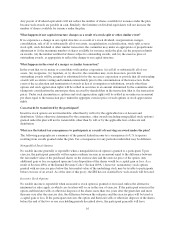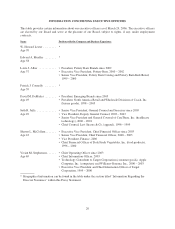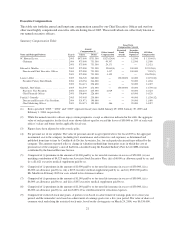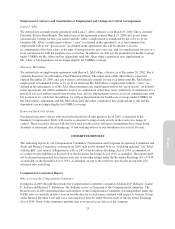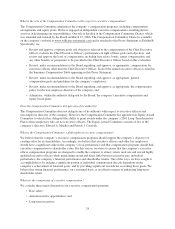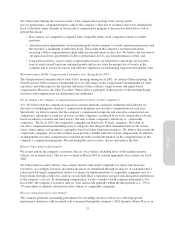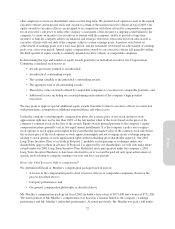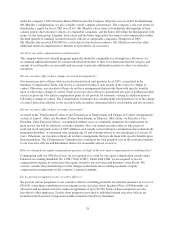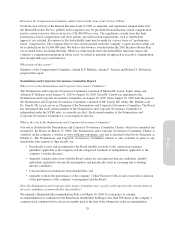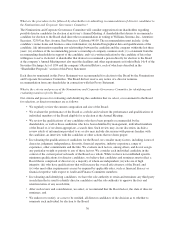Pottery Barn 2005 Annual Report Download - page 113
Download and view the complete annual report
Please find page 113 of the 2005 Pottery Barn annual report below. You can navigate through the pages in the report by either clicking on the pages listed below, or by using the keyword search tool below to find specific information within the annual report.
We believe that offering the executive team a total compensation package with a strong at-risk,
pay-for-performance component helps to achieve the company’s objective of creating value for its shareholders.
Each of the three major elements in our executive compensation program is discussed in detail below, but in
general this means:
• Base salaries are competitive compared with comparable public retail companies relative to similar
positions;
• Annual incentive opportunities are based principally on the company’s overall corporate performance and
the executive’s attainment of individual goals. This results in the company’s strongest performers
receiving a better compensation package while poorer performers receive less. We believe the structure of
our annual incentive opportunities fosters a performance-driven, pay-for-performance culture; and
• Long-term incentives, such as equity compensation awards, are structured to encourage our executive
team to work toward long-term sustained growth and success from the perspective of owners in the
company and to reward executives and other key employees for maximizing long-term shareholder value.
How many times did the Compensation Committee meet during fiscal 2005?
The Compensation Committee held a total of five meetings during fiscal 2005. At certain of these meetings, the
Chief Executive Officer made recommendations to us with respect to the compensation arrangements for other
executives and with respect to the structure and terms of those officers’ target bonuses and equity-based
compensation. However, the Chief Executive Officer did not participate in the portions of the meetings during
which his own compensation was deliberated and established.
Do we compare the company’s compensation practices to those of other companies?
Yes. We believe that the compensation practices of many different companies within the retail industry are
relevant to establishing the company’s compensation programs and executive compensation for each year.
Specifically, we strive to ensure that the company’s compensation programs and executive compensation are
competitive, taking into account pay practices at other companies considered by us to be comparable each year,
based on industry, revenues and other factors. We refer to these companies collectively as “comparable
companies.” For fiscal 2005, the comparable companies included over 30 retail companies. We relied on
executive compensation benchmarking surveys and proxy data that provided summarized data levels of base
salary, target annual cash incentives, and equity-based and other long-term incentives. We believe that among the
comparable companies, survey data in these areas provide a reliable indicator of total compensation. In addition,
an independent executive compensation consultant provides us with information on the competitiveness of the
company’s compensation programs. We met during the year to review, discuss and analyze the data.
How are base salaries determined?
We review and set the company’s executive officers’ base salaries, including those of the named executive
officers, on an annual basis. This review occurred in March 2005 to confirm appropriate base salaries for fiscal
2005.
We believe that executive officers’ base salaries must be sufficiently competitive to attract and retain key
executives. Accordingly, base pay and annual increases are determined through an analysis of each individual’s
salary and total target compensation relative to salaries for similar positions at comparable companies and, to a
lesser extent, through a subjective analysis of each individual’s experience and past and anticipated contributions
to the company’s success. In determining compensation, we also consider overall company performance. For
fiscal 2005, the company’s executive officers’ base salaries fell generally within the third quartile (i.e., 50th to
75th percentile) of similarly situated executive officers at comparable companies.
How are annual incentives determined?
The company promotes outstanding performance by rewarding executive officers for achieving specific
performance objectives with an annual cash bonus paid through the company’s 2001 Incentive Bonus Plan or, in
25
Proxy



